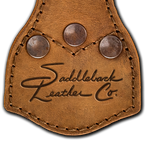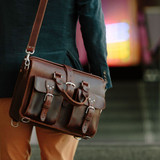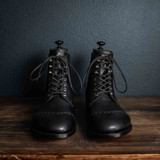But WHY are the Leather and Materials Considered High Quality?
Who cares if someone uses leather tanned with unicorn tears and the sweat of 40 virgins, if it doesn’t hold the shape of the shoe well and is a lot of work to keep looking nice after a few years. We only use high quality leather for our shoes to wear well and look sharp for decades. It is expensive because it is time consuming and expensive to make, not because it is rare with a cool story. But doesn't everybody say they use high quality leather? I will explain to you the detailed reasons WHY the leather and material for our shoes is considered such high qualitiy and some is not.
What I'm about to share with you came from 23 years of making a living designing and selling high quality leather goods and asking lots of technical questions to the owners of Vegetable and Chrome tanneries around the world, which was confirmed by leather scientists from Germany and Italy. I'm just passing on what they said in these places:
- The 2013 Tannery of the Year for North and South America, who has only gotten better with time.
- The German tannery that provides the automotive leather for all of the most expensive car brands in the world.
- A high end Spanish tannery.
- The oldest tannery in England that makes sole leather for the who's who of the world, with the 14 month process they made it for the Romans 1000 years ago.
- Two of the oldest tanneries in the Ancient Leather Capitol of the World in Morocco. I watched and learned how they tan with pigeon poop and color the leather naturally.
- Several of the finest tanneries in the High Quality Leather Capitol of the World, Italy.
- Some of the lowest quality tanneries of the world in Mexico.
Because I ask a million questions, I will explain here:
1. WHY I chose our specirfic leather for these shoes?
2. Specific reasons WHY one leather is high quality and one is not?
3. Which is better, Vegetable or Chrome tanned leather?
4. All about the pros and cons of Vegan Leather versus Natural Leather. Here is where I've investigated:
5. Why is Italian leather considered so good?
What I'm about to share with you is not from something I read on a blog written by someone who reworded the information the read on another blog who reworded the information from another blog that was written by an ignorant 19 year old who has no clue about leather, but makes a living writing blogs about anything people will pay him to write for. Nor was this a ChatGPT AI generated blog that eventually quotes itself as the source of authority.
Four Reasons Why Our Shoe Leather Is High High Quality
There are four reasons why the leather we make our shoes with is the strongest we know of. Because of how tightly bound together the fibers are of the particular cow we use. Because of the type of leather tanning we chose, Because of how the particular tannery we use turns that skin into leather. And because of the particular places on the hide we cut the shoe pieces from. Let me explain.
Northern European Cows Are Tougher
A German leather scientist explained to me that the main reason European cows produce skin with a tighter collagen structure (the fibers in the leather are more dense and tighter together) is because the cows are usually slaughtered at 24 months when the old slow grown skin is mature. Like an oak tree, skin is stronger when it takes longer to grow. Their constant quality feed also affects the integrity of the fibers. Some say that the constant extreme cold in Scandinavia causes the top layer of grain to thicken for their defense.
Little Cow Skin - Big Bull’s Body
Sadly, because the U.S. government doesn’t love their citizens, our cows get jacked full of growth hormones so they grow to full maturity in 15 to 18 months, but their skin does not. It’s like when a woman gets pregnant and her belly grows so fast that the skin stretches out and the mother gets stretch marks where the skin broke down. It’s the same with North American cows. Their skin is still strong, but not as strong as the skin of European cows.
Why We Waste Leather
The tough and dense grain layer makes up the top 20% and is the strongest, tightest, densest part of the hide and shows the natural scars and marks of the cow. We cut around those marks and throw a lot of those scars away. Many companies save a lot of money by buying leather with the top layer of marks sanded off so they don’t have to throw as much leather away, but there is only a little grain left on top. That’s Top Grain leather. Ours still has the full amount of grain on it. That’s Full Grain leather and it's super tough.
Cut Against The Stretch
Cows have more stretch in their skin in the direction from spine to belly than from head to tail, and if shoes are going to stretch, they won’t stretch longer, they’ll stretch wider. So, we cut all of the pieces of the shoe so the stretch of the leather goes against the stretch of the shoe. We have to throw away a lot more leather than most companies do, but our shoes maintain the shape of the shoe a lot longer because of that.
Say No To The Belly
From the tips of the ribs down to the cow’s belly button, the fibers of the leather are a lot softer and looser because the belly is constantly expanding and contracting. Our Italian tannery cuts the belly off before they tan the tight part of the hide and sell all of that protein (skin) to make things you don’t want to know about. We can cut about 2 pairs of shoes out of each hide. Low quality shoe companies can cut up to 5 or 6 because they’re cutting at all angles and from the belly too.
Reinforce The Vulnerable Toe
We cut our toe caps from the absolute tightest part of the cow, nearest the spine by the tail, because it reinforces the most vulnerable part of the shoe to maintain the good looking shape and to resist tears from a life of kicks and scrapes.
The toe cap of a lot of shoes is either randomly cut from the hide or is not even a second protective layer. They deceivingly make the toe to be a separate piece from the body of the shoe and then put a seam there to make it look like it's a reinforcing cap on top of the toe, but it's not.
Good Cow Food Matters
We could buy much cheaper hides from 3rd World countries, but when cows get varied feed with low nutrition, the thickness of the hide varies from one spot on the hide to the next. It's the same with the thick and thin rings of a cut tree. They tell the story of tree's history of rain, drought, sunlight and nutrition, year by year. The tougher the life, the thinner the ring. Why varied thickness is bad with leather is because if we sew one piece of thicker leather to a thinner piece cut from the same hide, then that affects the integrity of the shoe in a couple of ways. American and European leather normally has a fairly even thickness.
Vegetable Tanned Leather
If a person walks around London all day long, they’ll probably take about 20,000 steps, which means each shoe gets the foot lightly bumping into the top and sides of it from the inside about 10,000 times. We chose vegetable (veg) tanned leather because it’s the best leather for shoes to keep their shape over thousands of miles of bumping and pushing. Let me explain why that is.
Tiny Tannins Tan Tighter
Vegetable tanned leather is soaked in wood and plant fibers called tannins. They bond to every last fiber of the hide and as they dry, they shrink up and pull the leather fibers super closer to eachother. Now they're even tighter than they were before. Since tannins are wood based, the leather tends to be a little stiffer, which makes it memorize the shape of the shoe when it dries on the last. The tannins also make the already tough leather fibers even more resistant to stress.
Tanning The Italian Way
I've learned the tanning processes from the Germans, the most impressive tannery in England, the oldest tannery in the world in Morocco and the North and South American Tannery of the Year in Mexico, but I was blown away when we watched and learned the tanning process and the extra time consuming steps of our tannery, which is one of the top tier tanneries of the 700 tanneries in Italy. There's a reason they are the go to tannery for the who's who of the fashion world.
Let The Feasting Begin
As soon as a cow dies, bacteria starts eating away at the hide. The hides our tannery buys are freezing most of the year in Scandinavia so the bacteria is not active and as soon as it arrives to Italy it is put in a big refrigerator at 2 degrees above freezing until they are ready to start tanning it. Most places salt the hides to slow the bacteria feast down, but it doesn’t stop it. Many tanneries I’ve seen leave their hides out in the warm air for the bacteria to eat away at the grain of the hide for weeks before they start tanning it. And it usually took a week to get to them from the slaughterhouse.
Tumbling and Tumbling and Tumbling
Next, the Italians leave the hairy hides in for a long time with lime, which eats up the hair follicles so the hair just falls out. Most places treat the hides harshly for a few hours because they’re in a hurry to tan the hide. That causes the hair to kind of breaking off or getting ripping out and that weakens the leather by damaging the top tough layer of grain permanently. Instead of tumbling the leather with tannins and fats for hours, the Italians do it for days.
Letting Leather Marinade
Sloppy wet, they neatly stack the folded hides and leave them for 3 or 4 days pressing down on itself to let the tannins and other ingredients really soak and penetrate evenly and to re-orient the leather fibers in the same direction. The Germans call this process “Oiling”. Nobody I’ve seen does that but the Italians. The same natural fats that they took out in the beginning of the process, are treated and mixed with other natural oils and ingredients to re-insert back into the same microscopic spaces they were designed to perfectly fit into. The fats fit in like a hand fitting into the a glove made perfectly for it which doesn’t leave any microscopic gaps. Most tanneries take the fats out, but insert synthetic oils that don’t bond nearly as tightly with the collagen fibers as the natural fats do.
A Hearty Sole
Our original plan was to sole our shoes with outsoles from Baker Tannery in Southern England, which is one of only 4 tanneries in the world who make a sole so longlasting and durable. They take 14 months to tan their leather. After delivering a portion of our order, they informed us they couldn't provide us with the amount we needed. So, we're saving them for a super special limited run of shoes and we moved to second best, which are longlasting leather soles tanned in Italy. The common leather sole in North America is rushed through the veg tanning process in 2 to 3 weeks, but only lasts half as long before the shoe needs to be resoled.
A Footbed Built For A King
Our slab of thick 4mm to 5mm veg tanned insole footbed is intentionally nearly twice as thick as almost everybody else's we know of. I'm sure you can imagine the comfortable indentations that will form perfectly to your foot after one million steps of pressing your full bodyweight on it. Most insoles are a max 3mm thick and some cheat and use a synthetic or cardboard insole and then glue a thin layer of leather on top of it to trick you into thinking it's leather.
Healthy Lining
We chose cowskin over synthetic for lining because it lasts the life of the shoe, it breathes, it’s not too hot or cold, it doesn't make my feet sweat, bacteria doesn’t grow on it and stink, if the shoe gets soaked then the leather and lining dry at the same rate, and because it’s healthy and natural. Synthetic lining is a low class alternative and the opposite of all that leather is. We know oils absorb into the bloodstream through the feet so why wouldn't an oil based lining leach chemicals into the body too? And the idea of my feet sitting in a nasty bacteria bath all day long isn't pleasant.
Thinner Tongues Are Better
A high quality tongue is always made of full grain leather so it is extra tough for the tugging. People use thick tongues because they cut them from the belly and that leather will tear if it’s too thin. You really want a thin tongue for many reasons. First, it’s the vent hood for the shoe. It lets warm air and moisture evaporate out. It is comfortable because it doesn’t get bunched upon the instep (top of your foot). It’s easier to get the foot in and out of. And, being thinner doesn’t increase protection of the foot against water, mud or dust.
Welt Goest Thou
A welt is a strip of leather about ½ inch wide that is sewn around the edge of the upper part of the shoe and then is sewn down to the sole. It’s like a gasket between the top and bottom of the shoe. We have a thick and strong leather welt so we can put more tension on the machine to sew it tighter to the sole. Machines can’t sew synthetic or cheap leather welts with as much tension because the thread may tear through it. A poorly sewn welt squeaks and synthetic ones deteriorate. When a cobbler resoles a shoe with a synthetic welt, there are usually salt crystals all around the welt because it stopped the shoe a little from breathing like it would through a leather welt.
No Cork Pudding For You
When we attach the upper to the insole, we end up with a raised up rim of upper leather around the bottom of the insole. In order to fill the gap between the raised edges so the whole bottom is even and flat when we sew the sole to it, most places fill that gap by smearing a cork paste glue into it with a spatula. That cork glue often starts squeaking with every step once it gets dried out. We cut out a perfectly shaped slab of leather to fill in the gap. That is part of the cushioning that forms to your foot and stays does not need to be replaced when your shoe is resoled. It's more expensive but worth every Euro.
An Unforgettable Hook
I saved one of my favorite materials for last. Our military grade speed hooks and eyelets are 4 to 5 times more expensive than all others we could find and here’s why. Normal hooks and eyelets are pressed out of some sort of thin sheet metal, but they eventually bend out of shape when tying shoelaces and have to be bent back with your thumb. I’ve had them break off after too many bends. Ours are 70% copper and 30% zinc, which is the hardest brass possible. They don’t bend. In fact, the hooks are so reinforced that they have to be cut from a brass rod with a steel knife. They are fixed in place with a metal washer backing instead of just starred out on leather.
Heelstack Heaven And Hell
The leather of our heelstacks is solid Italian tanned durable leather that gives all of the cushion a normal foot needs. Watch out for heelstacks that have leather on the top and bottom layers but the middle layers are cardboard, colored to look like leather. Or they aren't leather at all but they look like it. Watch out for hollow heelstacks too, but you'll never know unless you cut it open.
Why Vegetable Tanned Leather Is The Best For Most Shoes
Both Chrome and Vegetable tanned leather are excellent to make shoes with, but if it is a cleaner look you are after and you require it to maintain its shape and look clean and nice for decades, then Veg tanned leather is the way to go. Here's why.
If a person walks around London all day long, they’ll probably take about 20,000 steps. That means each shoe gets the foot slightly bumping into the top and sides of it about 10,000 times. Times 100 days = 1,000,000 bumps and rubs.
Vegetable tanned leather has ground up pulverized wood fibers called tannins added to the water as it is being made into leather and when that fully permeates the leather and then dries, it shrinks up the leather and pulls the collagen fibers together super tightly. That makes it stiffer than chrome tanned leather that is tanned with chromium, which does not shrink up and pull fibers together.
Chrome tanned leather gets veg tannins in the second process of re-tanning, but a max of only 35%. That's why chrome tanned leather is a little more flexible and better for other applications. Because of the tightness of veg tanned leather, it memorizes and holds the shape of the shoe last that the shoe is formed around.
Our Italian shoe workshop leaves the leather on the shoe last for 48 hours to dry at room temperature so it memorizes the shape even better than if it is dried quickly in an oven and moves its location on the last as it quickly shrinks into shape.
Even rocks where away. We chose vegetable (veg) tanned leather because it is the best leather for shoes to keep their shape over thousands of miles of bumping and pushing on the leather from the inside.
Chrome tanned leather is better for work boots that will be constantly in the mud, which dries out veg tanned leather faster and makes it crack sooner than it would with Chrome.
Which is Better? Chrome Or Vegetable Tanned Leather?
When someone asks, "Which is stronger, vegetable tanned leather or chrome tanned leather? That's like asking, which is stronger, "Brass pr Bronze ? They're both amazingly durable and far better than any synthetic material in the world. And both have a wonderful smell that draws men like moths to a flame.
When someone asks, "Which type of leather is better, Vegetable or Chrome tanned leather?" That's like asking, "Which tool is better, a saw or a hammer?" Vegetable tanned leather and Chrome tanned leather are both excellent materials and one is better than the other, depending on what you’re using it for.
To answer those questions, you have to first understand the physical differences of Vegetable tanned (Veg) and Chrome tanned leather.
Vegetable Tanned Leather
Vegetable tanned leather is soaked in wood or plant based fibers called tannins. They bond to every last fiber of the hide and as they dry, they shrink and pull together all of the leather fibers they’re connected to and they end up very close and tighter than they were before. I tasted
Since Vegetable tanned leather tends to be stiffer and tighter, it memorizes the shapes of what it is formed around when it dries and makes it even more resistant to abuse. It can be more flexible or less depending on how much tannin it is tanned with.
Uses:
Shoe soles, High end shoe uppers, firefighter helmets, saddlery, holsters, knife sheathes, tooling art, belts, floor tiles.
Pros:
-
Doesn’t stretch much
- Patinas nicely
- Insulative against heat or cold
- Fire retardant
- Breathable for airflow
-
Molds to or maintains the shape that it dries around because of it’s stiffness.
-
Edges burnish easily
-
Italian Vegetable tanned leather
-
Our Italian veg is not affected by water like a lot of veg tanned leather is
-
Tannins shrink, contract and pull together the fibers to be even denser than they were before.
-
Memorizes the shape better
- Edible in an emergency. There are stories of starving people boiling their veg tanned shoes to eat.
-
Veg tanned leather molds to and holds the shape better because of the wood fibers inside of it.
Cons:
- Expensive because therer is not as much demand for it.
- Takes longer to tan, sometimes up to 24 months
- Does not bend on tight edges well
- Does not fold tighly without cracking
- Does not play well with water and spots
- Requires regular maintenance
- Dries out and cracks when old if not hydrated
- Gets wavy and lumpy when it gets wet and then dries again.
- Unless finished with natural fats and oils at the end of the process, it can have problems with water spots.
- Smells better
Chrome Tanned Leather
Chromium is a mineral (Cr on the Periodic Table) and that is why it's often called Mineral tanned leather. When the hide is tanned, the leather ends up containing about 4% chromium. About 90% of the world's leather is Chrome tanned leather and the first option for many reasons. Chrome tanned leather is always tanned with a smaller amount of tannins to pull the leather together tighter, but because Chromium does not pull leather together as tightly as tannins do, it is a more flexible leather.
Uses:
Best for car seats, jackets, furniture, gloves, hats and work boots. upholstery, luggage,
Pros:
-
Chromium is added to preemie baby formula and diabetic and athletic supplements because it’s healthy for us.
-
It is super resistant to corrosion and that’s why it’s the main ingredient in stainless steel.
- Fire retardant
-
It is softer and flexible because it doesn't shrink up when it dries like Vegetable tanned leather does.
-
Thrives on neglect.
- Breathable for airflow
-
Loves water
- Insulative against heat and cold
-
Is faster to produce.
- Is less expensive because of economies of scale. So many tanneries make it that supplies are less expensive and they make higher volumes of it.
- Can come in a lot more brighter colors.
-
Stretches more easily around tight corners and sharp bends like dashboards
Cons:
-
Unregulated 3rd World tanneries dump high concentrations of Chromium into rivers which temporarily lowers oxygen levels and hurts fish and plants.
-
IF Chromium III oxidizes for a long time and at too high of a heat, like in heavy industrial stainless steel manufacturing, it can convert to Chromium VI (hexavalent Chromium), which is carcinogenic. It has happened in the past, but was rare for Chromium in leather to oxidize like that. It is unheard of today and would almost have to be intentionally done.
-
Does not hold indentations unless they are intentionally pressed in with heat.
Vegan Leather or Natural Leather. Which is Better?
First, let me say, I am a person for the ethical treatment of animals and God wants us to be too. I am fiercely against anyone causing the intentional suffering of animals and those in charge of certain animal farms that I’ve seen documentares on. They should be put in prison. They are a shame to their children and history will forget them. Secondly, if you choose a vegan diet for health reasons, I am 100% behind you. I really hope it helps.
Facts about Vegan Leather
According to The American Heritage® Dictionary of the English Language, 5th Edition, the word leather is defined as:
Animal Leather
-
The dressed or tanned hide of an animal.
-
Any of various articles or parts made of dressed or tanned hide, such as a boot or strap.
-
The flap of a dog's ear.
- A collagen, which is a protein.
Vegan leather
A type of material made without any animal products using a synthetic petrochemical material like polyurethane or polyethylene as a base layer, with a thin layer of plant-based source such as pineapple, cactus or mushrooms on top. It serves as an alternative to traditional leather and therefore much effort is put into making it look like leather.
*It is illegal to use the term 'vegan leather' in Italy because it has been ruled as a deceptive marketing practice.
Veganism definition:
“Veganism is a way of living which excludes all forms of exploitation of, and cruelty to, the animal kingdom, and includes a reverence for life. It applies to the practice of living on the products of the plant kingdom to the exclusion of flesh, fish, fowl, eggs, honey, animal silk, and it’s derivatives, and encourages the use of alternatives for all commodities derived wholly or in part from animals.”
Is Leather Art?
Depriving of the Joy of the Naturalness
Wastes Money
Detracts from your Beauty
Is it Unethical or Unbiblical to Use Natural Leather?
I believe the Bible is true and God is perfect and He filled the Bible with what He has determined is true. Whatever I think that is different, I have to adjust to what is true and right, even if I don't understand and no matter what my emotions may tell me. God's standard is perfect and if we don't believe that God is right just because we don't understand, then that's a bigger issue.
Is it wrong to use leather?
After creation, leather was the first thing God made. God killed an animal and turned its skin into leather to make clothes for Adam and Eve. Vegans who say using the skin of animals is wrong, would have to say what God did was wrong too.
Genesis 3:21 And the LORD God made garments of skin for Adam and his wife, and He clothed them.
What does God say about treating animals kindly?
Proverbs 12:10 A righteous man regards the life of his animal, but the tender mercies of the wicked are only cruelty.
Psalm 145:9 The LORD is good to all; His compassion rests on all He has made.
Did you know that God loves animals and cares for them?
Psalm 14:9 He provides food for the animals, and for the young ravens when they call.
Matthew 6:26 Look at the birds of the air: They do not sow or reap or gather into barns, and yet your heavenly Father feeds them. Are you not much more valuable than they?
We're supposed to be kind to animals, so it's it wrong to kill animals to eat meat?
God doesn't contradict himself, so there must be two different topics here. My daughter has never liked eating meat and prefers vegetables. That is fine. It is not a conscious issue, but a taste thing. She also doesn't like the smell of leather, which I think is crazy. But she doesn't push her views on anyone else so they think the same. To say it is wrong to eat meat is to say that God is wrong to suggest it.
Genesis 9:3 Everything that lives and moves will be food for you; just as I gave you the green plants, I now give you all things.
1 Corinthians 8:8 But food does not bring us closer to God: We are no worse if we do not eat, and no better if we do. (about meat)
1 Timothy 4:3 They will prohibit marriage and require abstinence from certain foods that God has created to be received with thanksgiving by those who believe and know the truth. 4 For every creation of God is good, and nothing that is received with thanksgiving should be rejected, 5 because it is sanctified by the word of God and prayer.
Is it wrong to kill animals just for their skin?
I am strongly opposed to killing animals only for their skin. That is wrong and God is opposed to those people too.
Today, cows are not killed for their skin just like a banana is not killed for its peel. In the U.S., about 5 million cowskins are thrown into landfills every year where they decompose and emit huge amounts of CO2 gasses. Like a banana, no one peels the banana and throws away the inside. No! They take the peel off and eat the middle part. It’s the same with cows. They peel the cow and eat the middle part too. So, turning the skin into a durable longlasting material is good.
Is it wrong to kill animals for sport?
Depends. I would say make sure the meat is eaten so the animal is not killed in vain. This next topic makes me sad, but I have to look at what is best for the overall good. Big game hunters pay sometimes up to $150,000 for a single permit to kill an old lion or leopard that is about to die anyways. And that money goes to cover the costs of keeping the fence intact that protects the other rare and precious animals like rhinos, elephants and big cats inside the game park from poachers. And those fences keep the smaller meaty animals inside and from being killed all year long by the neighboring communities. It also creates good paying jobs for rangers to protect against poachers. Now they have a way to pay for medical and education for their families. Those fees also covers the cost to feed the animals and to truck water in to keep them alive in dry season. If there wasn't money paid for permits, we wouldn't have these beautiful animals to enjoy.
Based on the scientific facts, someone could argue that using vegan leather is wrong and unethical. It is unloving and damaging to the animal kingdom, the environment and all of humanity and it is hurtful to you because it damages to your health, damages your self-esteem, deprives you of art in your life and wastes your money. It seems to me that using leather is the right and good thing to do.









